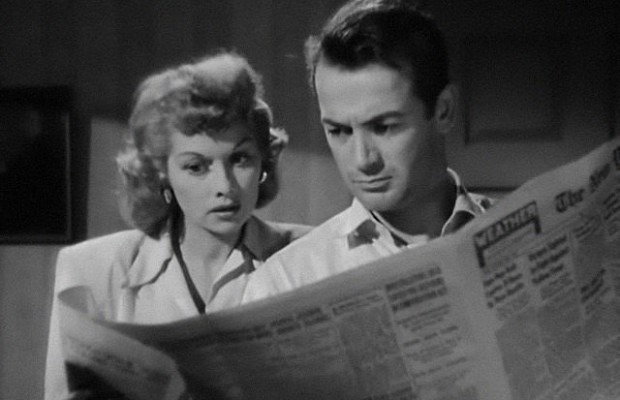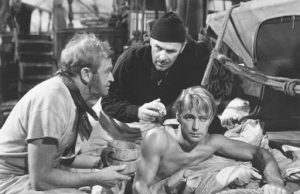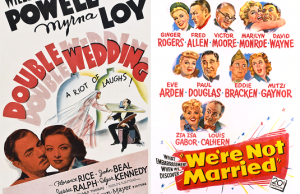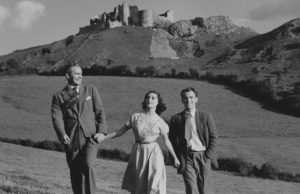The Dark Corner (1946)

Toronto Film Society presented The Dark Corner (1946) on Monday, September 28, 2015 in a double bill with Deadline at Dawn as part of the Season 68 Monday Evening Film Buff Series, Programme 1.
Toronto Film Society presented The Dark Corner (1952) on Sunday, October 15, 1989 in a double bill with The Long, Long Trailer as part of the Season 42 Sunday Afternoon Film Buffs Series “A”, Programme 2.
Director: Henry Hathaway. Production Company: 20th Century Fox. Producer: Fred Kohlmar. Screenplay: Jay Dratler, Bernard Schoenfeld. Story: Leo Rosten. Photography: Joe MacDonald. Special Effects: Fred Sersen. Art Direction: James Basevi, Leland Fuller. Editor: J. Watson Webb. Musical Score: Cyril Mockridge. Sound: W.D. Flick, Harry M. Leonard. Sets: Thomas Little.
Cast: Lucille Ball (Kathleen Conley), Mark Stevens (Bradford Galt), Clifton Webb (Hardy Cathcart), William Bendix (White Suit), Kurt Kreuger (Tony Jardine), Cathy Downs (Marl Cathcart), Reed Hadley (Lt. Frank Reeves), Constance Collier (Mrs. Kingsley), Molly Lamont (Lucy Wilding), Forbes Murray (Mr. Bryson), Regina Wallace (Mrs. Bryson), John Goldsworthy (Butler), Charles Wagenheim (Foss), Minerva Ureal (Mother), Raisa (Daughter), Matt McHugh (Milkman), Hope Landin (Scrubwoman), Gisela Verbisek (Mrs. Schwartz), Vincent Graeff (Newsboy), Frieda Stoll (Frau Keller), Thomas Martin (Major Domo), Mary Field (Cashier), Eloise Hardt (Saleswoman), Steve Olsen (Barker), Eddie Heywood and His Orchestra.
FILM NOTES COMPILED BY AIDEEN WHITTEN, TFS, 1973:
(Source: “Notes on Film Noir” by Paul Schrader in Film Comment, Spring, 1972)
In 1946, French critics, seeing the American films they had missed during the war, noticed the new mood of cynicism and pessimism which had crept into the American cinema. The darkening stain, most evident in routine crime thrillers, was also apparent in prestigious melodramas. As the years went by, lighting grew darker, characters more corrupt, themes more fatalistic, and the tone more hopeless. By 1949, American movies were in the throes of their deepest and most creative funk. Never before had films dared to take such a harsh, uncomplimentary look at American life, and they would not dare to do so again for twenty years.
Film-noir was an immensely creative period—probably the most creative in Hollywood’s history. It seemed to bring out the best in everyone: directors, cameramen, screenwriters, [and] actors. Although it is also a sociological reflection, Film-noir went further than the gangster film. It attacked and interpreted its sociological conditions and, by the close of the Noir period, created a new artistic world–a nightmarish world of American mannerism which was, by far, more a creation than a simple reflection of its society. The overriding Noir theme is a passion for the past and present, but also a fear of the future. The Noir hero dreads to look ahead, but instead tries to survive by the day, and if unsuccessful at that, he [or she] retreats to the past. Thus Film-noir’s techniques, combining realism and expressionism, emphasize loss; nostalgia; [a] lack of clear priorities; [and] insecurity, then submerge these self-doubts in mannerism and style.
Film-noir is not a genre; it is not defined by conventions of setting and conflict but, rather, by the more subtle qualities of tone and mood. It is also a specific period of film history and, in general, refers to those Hollywood films of the 1940s and early-1950s which portrayed the world of dark, slick, city streets, crime, and corruption. Though all these dates overlap, Film-noir can be divided into three broad phases. The first, the wartime period, 1941-1946, was the phase of the private eye and the lone wolf. The Studio look of the period was reflected in The Maltese Falcon, Laura, and Phantom Lady. The second phase was the post-war, realistic period, from 1945-1949. These films tended more towards the problems of crime in the streets, political corruption, and police routine. The urban look of this phase is seen in Force of Evil, The Killers, and Boomerang. The third and final phase, from 1949-1953, was the period of psychotic action and suicidal impulse. The forces of personal disintegration were reflected in They Live By Night, On Dangerous Ground, and Sunset Boulevard. The third-phase films were painfully self-aware; they seemed to know they stood at the end of a long tradition based on despair and disintegration.
By the mid-1950s, Film-noir had ground to a halt; Americans were eager to see a more bourgeois view of themselves. For a long time, Film-noir, with its emphasis on corruption and despair, was considered an aberration of the American character. It has recently become the subject of renewed interest, as American movies are again taking a look at the underside of the American character, but compared to such relentlessly cynical Films-noir as Kiss Me Deadly or Kiss Tomorrow Goodbye, the new self-hate cinema of Easy Rider and Medium Cool seems naïve and romantic. As the current political mood hardens, the 1940s may become to the 1970s what the 1930s were to the 1960s.
The Dark Corner, with its combination of private-eye hero, explosive action, and use of realistic New York backgrounds, bridges the first and second phases of Film-noir. The expert cast—Mark Stevens’ convincing hero, Lucille Ball’s acid-tongued secretary, Clifton Webb’s acerbic art dealer, [and] William Bendix’s menacing “tail”—add immeasurably to the enjoyment of this nightmarish mystery. Henry Hathaway is one of Hollywood’s most prolific directors, with nearly sixty films to his credit–from Wild Horse Mesa in 1932 to Shoot Out in 1971. A robust, skillful director, his films run largely to action and adventure. Kiss of Death, Call Northside 777, and Fourteen Hours are other Films-noir to his credit, and The House on 92nd Street was the first film to combine documentary techniques with the dramatic.
FILM NOTES COMPILED BY CAREN FELDMAN, TFS, 1989:
This evening, we are showing two diverse films which star the talented Lucille Ball. We mostly know her for her comedic acting; however, in this first film, we also see her as a dramatic actress.
In the book Loving Lucy, by Bart Andrews and Thomas J. Watson, they say the following: “Striking out on her own in late-1945, Lucille Ball was reminded of the importance of past associations, the result of her propensity for making and keeping friends within the industry. One of those friends was Fred Kohlmar, the man who first brought her to Hollywood in 1933, when he was a talent agent for Sam Goldwyn. Kohlmar, who had since become a producer at 20th Century Fox, called Lucy during her final weeks at MGM and invited her to co-star with Stevens and Webb in The Dark Corner. Murder mysteries were not typical Lucy fare, so on the first day of filming, she was admittedly nervous. Her first scene called for her to be behind a desk, typing. During the lunch break, the director noticed what it was that she had typed. The paper, still in the machine, read: ‘Dear Mr. Hathaway, If you knew how…nervous I was today you wouldn’t dare shoot the picture and you would call the whole thing off and then you wou….’ Further on down the sheet were the words, ‘Lucy is a sissy. Lucy is a sissy. Lucy is a sissy.’ When the “sissy” returned to the set for the afternoon scenes, she found a new piece of paper in the typewriter. On it was typed, ‘Dear Lucy, Would it help you to know that I’m nervous as hell myself? Love, H.H.’ The Dark Corner filmed for nearly three months, wrapping March 15, 1946.”
The New York Times said: “When a talented director and a resourceful company of players meet up with a solid story, then movie-going becomes a particular pleasure. This new melodrama is a tough-fibred, exciting entertainment revolving around a private detective who is marked as the fall guy in a cleverly contrived murder plot. Mark Stevens, a comparative newcomer looking and acting very much like Fox’s Dana Andrews, is convincingly hard-boiled as the baffled gumshoe, Bradford Galt, who knows he is being framed into a murder rap but has no knowledge of who is pulling the strings or why.
The trio of authors credited with The Dark Corner have not dealt all their cards above board. Their trump is a trick double-cross, but they have worked in that surprise with cunning and logic, so that the scattered story elements all fall together like so many pieces in a well-ordered jigsaw puzzle. The action, and there is plenty of it, is violent and explosive, starting with a going-over Galt gives a mysterious toughie who has been shadowing him. This character is identified only as White Suit, and is played with rugged naturalness by William Bendix.
In fact, Director Henry Hathaway has drawn superior performances from most of the cast. Lucille Ball has one of her happier roles as an acid-tongued secretary who shares the private eye’s troubles, and Clifton Webb has another chance as an art gallery proprietor to indulge his talent for acerbic characters. A strikingly good-looking girl named Cathy Downs is introduced as a sort of second ‘Laura’ in Mr. Webb’s cinematic marital affairs, but she is badly in need of dramatic training.
Mr. Hathaway has made such skillful use of the process screen in simulating a New York background that it looks as though the action was photographed in such locales as Third Avenue, Fifty-Second Street, and Broadway. And he happily eschewed murky photography for mood effect, using instead a muted and highly evocative musical score. His fine craftsmanship is very evident throughout The Dark Corner and it is regrettable that he had to mar the atmospheric realism by resorting to scene-faking in a few sequences. But this is a minor shortcoming in an otherwise sizzling piece of melodrama.”
Variety felt somewhat differently about this film: “Although The Dark Corner has all the ingredients of sock, hard-fisted melodrama, an overlong and loosely-woven script, and a scarcity of action where it would help most, militate a bit against it. Better editing job, clipping about 20 minutes off the running time, would have aided considerably. Starting off as another slam bang private investigator story, the first few reels are set at a fast pace. Stymied by an overabundance of dialog, however, the tempo gradually subsides and moves slowly to a so-so climax that misses because of the preceding draggy quality.
Cast, steered in the right direction by the director, does much to keep the picture running as smoothly as it does. Miss Ball is decorative and pleasantly emotional as the secretary. Bendix’s work as the immoral gunman is a far cry from his recent comedy parts, but it’s outstanding. Stevens, evidently being groomed by 20th [Century] Fox for star roles, is creditable as the tough private dick. Kreuger is sufficiently sardonic and handsome, and the beauteous Cathy Downs is okay as Webb’s wife. Eddie Heywood and His Orchestra get spot billing in the cast, but are seen in only one flash sequence.
Producer Fred Kohlmar has lined the picture with good accoutrements. Joe MacDonald, with emphasis on the trick mirror shots, gets in some top-drawer camera work, and Fred Sersen’s trick camera sequence of a body hurtling through the air from a skyscraper window is one for the books.”
Notes compiled by Hanna Miller














Leave a Reply